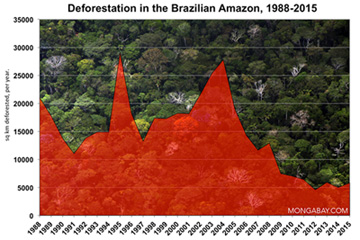Deforestation in the Brazilian Amazon fell to 291 square miles (754 square kilometers) in the November 2008-January 2009 window, a drop of 70 percent compared to the year earlier period when 976 sq mi (2,527 sq km), said Environment Minister Carlos Minc.
A decrease in forest clearing had been expected. Economic turmoil, which has reduced the availability of credit, and collapsing commodity prices — especially beef and soy — have undermined the main drivers of deforestation in the Brazilian Amazon. Minc also credited government efforts, including increased vigilance and new loan policies, for the decline.
The data is based on Brazil’s Real-time Detection of Deforestation (DETER) system for tracking deforestation. DETER is an alert system that updates IBAMA, Brazil’s environmental protection agency, with deforestation information, theoretically allowing authorities to attack illegal deforestation as it occurs. However the system requires on-the-ground follow up, something which is difficult due to poor land titling and political conflict between federal and regional authorities. From a technical standpoint, DETER is also thwarted by cloud cover — the latest deforestation data is only 60 percent complete. Brazil is developing an advanced satellite, the Amazon-1, that will use cloud-penetrating technology to allow more detailed monitoring of the Amazon.
 |
Nearly 20 percent of the Brazilian Amazon — which makes up roughly 60 percent of the world’s largest rainforest — has been destroyed since the early 1970s, but deforestation has slowed significantly since 2004. Last year the Brazilian government announced an ambitious plan to cut deforestation rates to 5,600 square kilometers (2150 sq mi) per year by 2014 in an effort to reduce carbon dioxide emissions. Deforestation presently accounts for two-thirds of Brazil’s greenhouse gas emissions.
Related articles

What does slowing economy mean for rainforest conservation?
(01/26/2009)
Plunging commodity prices may offer a reprieve for the world’s beleaguered tropical forests. The global economic downturn has caused demand for many commodities to plummet. The resulting decline in the prices of timber, energy, minerals and agricultural products may do what conservationists have largely failed to achieve in recent years: slow deforestation. Fueled by surging demand from China and other emerging economies, and boosted by the convergence of food and energy markets in response to American and European incentives for biofuels, the worldwide commodity boom over the past few years helped trigger a land rush that precipitated the conversion of natural forests for farms, plantations, and ranches. At the same time, high prices for metals, fossil fuels, and other industrial resources drove a global search for exploitable reserves, many of which lie in tropical forest countries. Now that the bonanza is unwinding, with prices for everything from palm oil to bauxite to crude oil cratering, the incentives to clear forests are retreating. Developers large and small are abandoning projects and forgoing planned expansion around the world.

Beef drives 80% of Amazon deforestation
(01/29/2009)
Nearly 80 percent of land deforested in the Amazon from 1996-2006 is now used for cattle pasture, according to new maps released today in a report by Greenpeace at the World Social Forum in Belem, Brazil. The report, Amazon Cattle Footprint: Mato Grosso: State of Destruction, confirms that cattle ranching is the primary driver of deforestation in Earth’s largest rainforest: the Brazilian Amazon.
Amazon rainforest damage surges 67% in 2008
(12/20/2008)
The area of rainforest in the process of being deforested — razed but not yet cleared — surged in the Brazilian Amazon during 2008, according to new figures released by Brazil’s National Institute for Space Research (INPE). The announcement comes shortly after the Brazilian government reported a 4 percent increase in forest clearing for the year. Using an advanced satellite system that tracks changes in vegetation cover INPE found that 24,932 square kilometers of Amazon forest was damaged between August 2007 and July 2008, an increase of 10,017 square kilometers — 67 percent — over the prior year. The figure is in addition to the 11,968 square kilometers of forest that were completely cleared, indicating that at least 36,900 square kilometers of forest were damaged or destroyed during the year. The sum does not include areas that may have been selectively logged for commercial timber.
Future threats to the Amazon rainforest
(07/31/2008)
Between June 2000 and June 2008, more than 150,000 square kilometers of rainforest were cleared in the Brazilian Amazon. While deforestation rates have slowed since 2004, forest loss is expected to continue for the foreseeable future. This is a look at past, current and potential future drivers of deforestation in the Brazilian Amazon.